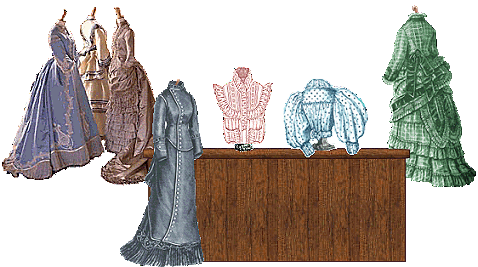
|
In early Victorian times, wealthy families made trips to London twice a year to purchase the latest fashions from stores such as Swan & Edgar, Fortnum & Mason, Harvey Nichols and Clark & Debenham. There were silks, furs and cashmeres, shawls, mantles and cloaks, lace and embroidery all on display. The smarter merchants realized that as the middle-class increased their wealth, their purchasing power was as important to them or even more so than the wealthy and thus began to stock their stores with machine-made linens and less expensive items fashioned after the latest styles.
Not only was Debenhams one of the first to sell machine-knitted garments including the "Jersey", a one-piece woolen trunk, with sleeves, they also sold small quantities of fabric to dressmakers at wholesale prices.
Up until the 1850s, garments were stitched by hand. The first sewing machine was developed in 1829; however, it was Isaac Merrit Singer's patent in 1851 which revolutionized clothing production. He is also credited as having been the first manufacturer to establish a chain of retail stores specializing in one product. The first paper pattern was Butterick, established in the 1860s in America and 1870s in Britain.
Clothing was pretty much made to order. Shoppers would examine sample garments and then they would be made at the time of ordering. Bainbridge of Newcastle in 1845 was one of the first to stock ready-made dresses. And Jay's General Mourning House of Regent Street advertised in the Illustrated London News in 1866 dresses ready for selection for a sudden bereavement.
You'll find articles in newspapers and magazines on "How to Buy Clothes" suggesting that low-priced garments should be avoided as they do not wear well and that the woman of meager means would do well to confine her purchases to some well-established shop known for quality goods rather than their inexpensive price. Words of advice also to female shoppers is to avoid trying to keep up with fashion, but to buy the best quality, "quiet coloured" garments they could find; clothes that are fashionable enough to be worn two seasons that can be restyled with new trimmings or alteration.
William Carter's Wholesale and Retail Stay Establishment is the place to go for ladies underpinnings as they offered the best items for the least cost. Petticoats are made in frilly muslin or lace trimmed; some even constructed in flannel for warmth. And to complete the outfit is a pair of silk stockings from Robertshaw's at 100 Oxford Street. The final touch, however, is the parasol and bonnet which can be purchased at W & J Sangster or Mrs. Poland's showrooms.
|
|
|||
|
|
|
||
|
|
|
Back to Intro/Index or Site Map
| | Family Gallery | Servants Parlour | Tour Home | Typical Day | Etiquette | Shopping Trip | |
| | Victorian Christmas | Victorian England Fun and Games | Ashton Library | Victorian Wedding | |
| | Victorian England Overview | Guest Registry | Honorary Victorian | Tours | |
| | Awards Received | Bibliography | |
| | 1876 Victorian England Home | |
Credits below copyright information |
| Contact
webmaster |
| Copyright
1999-2017 All Rights Reserved - B. Malheiro May not be reproduced in any way without express written permission of webmaster. |
Credits:
Background set, buttons and "Ladies Wear Department" are the creation of webmaster, B. Malheiro. These images have been digitally watermarked and are not for use on another site.